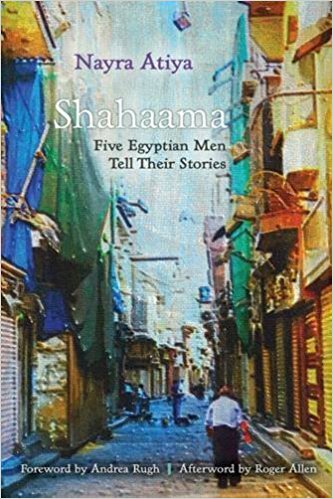
Shahaama: Five Egyptian Men Tell Their Stories
Alia Yunis
Nayra Atiya
2016, Syracuse UP, 978-0-81563-434-8 hb and 978-0-81561-061-8 pb, $49.95 and $19.95.
In 1982 Nayra Atiya wrote an award-winning oral history, Khul-Khaal: Five Egyptian Women Tell Their Story. This is the follow-up, based on interviews she recorded with Egyptian men in the same period and titled Shahaama after an Arabic word for doing the honorable thing. As Atiya tells it, personal circumstances and losing the original recordings for several years held the book back until now. The men, interviewed in their middle age, came of age under Gamal Abdel Nasser, the grandparents of the youth of Tahrir Square. There is optimism in their stories that one doesn’t hear much today. But this is a limited view: With the exception of a fisherman, the men come from Egypt’s then middle class. They are of different religions, a calculated decision on the part of the author, although religion as a source of political tension is not addressed. Nonetheless, these stories are compelling slices of life, depicting personal lives of 20th-century Egypt, particularly the early 20th century when the men talk of their childhoods.
You may also be interested in...
.png?cx=0.44&cy=0.65&cw=382&ch=487.6595744680851)
Zeina Abirached’s Art Uncovers Urgency of Wisdom in Gibran’s The Prophet
Kahlil Gibran’s 1923 classic is given new life, as Abirached’s graphic novel blends Lebanese artistry with the late author’s timeless wisdom.
Work Reveals Common Ground Across Massive Desert
The Sahara wasn’t always a desert. Around 9000 BCE it was a bucolic expanse where animals and lush vegetation thrived.